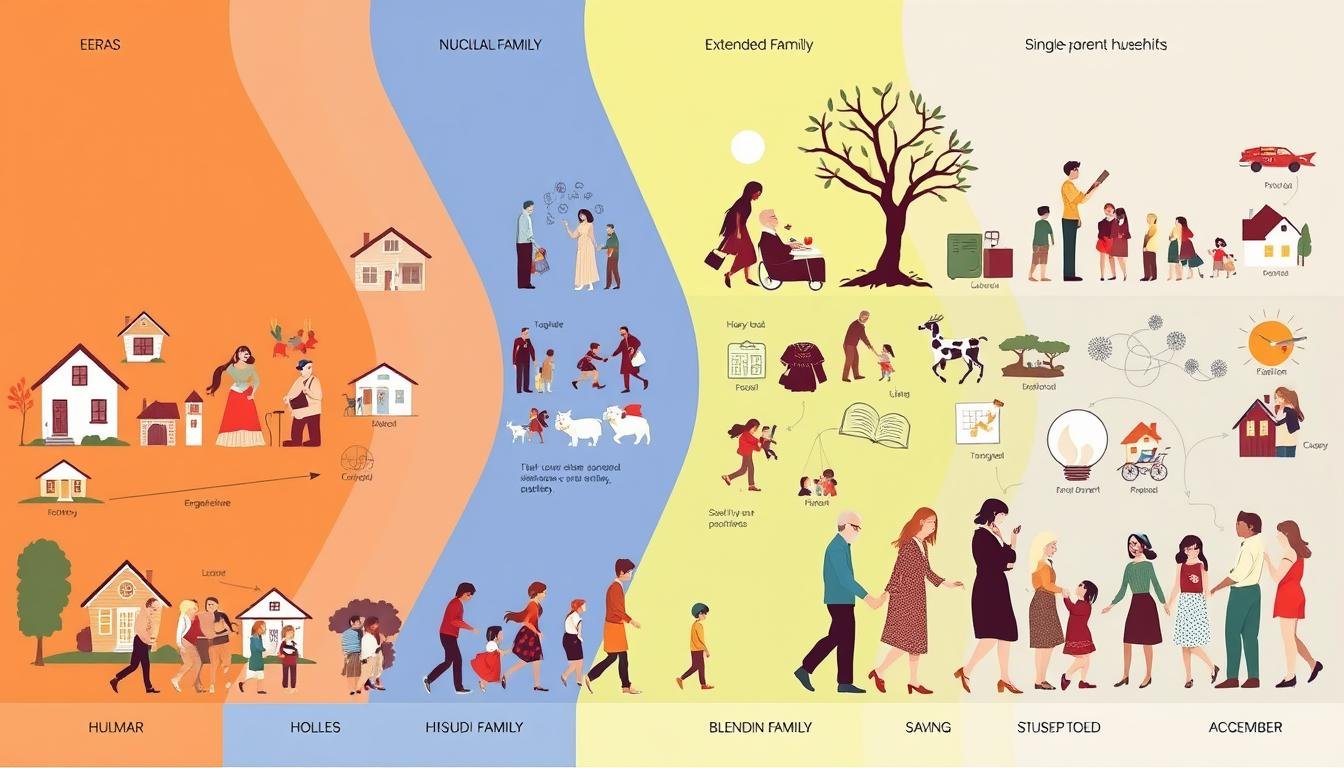The Sociology of the Family: Changing Family Structures
Ever thought about how family life has changed over the years? The study of family dynamics shows us a big shift in how we view and live family life. Things like fewer kids and changes in marriage are making society change in big ways.
In the UK, recent numbers show us these changes clearly. In 2020, the average woman had just 1.58 children, and moms were having kids at age 30.7. These numbers show us how women are focusing more on education and careers.
Family types have really changed. By 2015, only 66% of kids lived with married parents, down from before. But, more couples were living together, going from 11% to 15% in 10 years. About 23% of families with kids were single parents.
More couples are both working, and fewer families are coming together again. These changes show how gender roles and money issues are changing family life. Let’s look into how these changes affect society.
Key Takeaways
- UK fertility rates reached a record low of 1.58 children per woman in 2020
- Average age of mothers at childbirth increased to 30.7 years
- Married couple families decreased, while cohabiting families increased
- Lone-parent families remained relatively stable at around 23%
- Dual-career families are on the rise due to increased women’s participation in the workforce
- Family structures now include diverse forms beyond the traditional nuclear family
Introduction to Family Sociology
Family sociology looks at how family structures change and affect society. It gives a new view of family, including different kinds of family bonds.
Defining Family in Sociology
The term “family” in sociology now covers more than just the traditional family. This change shows how society’s values and norms are evolving.
Family Structure Importance
Knowing about family structures helps us understand society and policy. It shows how families affect people’s lives and society’s health. Families play a big role in child growth, economic stability, and helping each other out.
Recent Changes in Family Dynamics
Family life has changed a lot in recent years. These changes are linked to big shifts in the economy, culture, and technology.
| Year | Children in Two-Parent Households | Children with Single Parents |
|---|---|---|
| 1980 | 77% | Not available |
| 2010 | 66% | 27% |
There are fewer babies being born, people are getting married later, and more couples are living together without marrying. In 2011, about 7.5 million people were living together without being married. This shows how family life is changing in today’s world.
Historical Perspectives on Family Structures
Family history is a journey of change and growth. In the 19th century, lower-class families had more children for economic reasons. This changed with new laws and the Education Act of 1918.
William J. Goode’s 1963 study showed a big change in family structures worldwide. Traditional ways were changing to Western-style, with stronger marriages, fewer kids, and less multi-generational living.
The 19th century brought big changes to family roles. Husbands became the main earners, and wives focused on home and family. This fit with the rise of Western-style families and the job market.
“About one-fifth of children currently reside in the traditional breadwinner-homemaker family form.”
Demographic trends have changed family life a lot. In the 17th century, families usually had two to three kids who survived to adulthood because many died young. By 1900, the average number of children per woman was less than four. Now, people are marrying later and having fewer kids everywhere.
These changes show how families have evolved over time. They reflect big changes in society and the ongoing shift in family structures.
The Sociology of the Family: Changing Family Structures
Family sociology theories look at how family structures are changing today. In the 1950s, most US households had a married couple with one breadwinner. Now, we see many different family types. This change has led researchers to use new ways to study these shifts.
Core Concepts in Family Sociology
Studying how families form, break up, and come together is crucial. Sociologists see how social class affects families. For example, poor families struggle more with raising kids, getting them an education, and moving up in life.
Wealthier parents often give their kids a wide range of experiences. This helps improve their skills and chances for the future.
Key Theoretical Frameworks
Today’s family sociology goes beyond old ideas to look at conflict, power, and inequality. Feminist economists point out how gender affects families. They talk about the “family wage” and how it leads to women being stuck in certain jobs.
Methodological Approaches
Researchers use different ways to study how families change:
- Longitudinal studies follow families over time
- Cross-sectional surveys give us a look at family life now
- Qualitative research gives deep insights into family stories
These methods help sociologists grasp the many factors that shape today’s families.
| Income Level | Parental Engagement | Child Development Impact |
|---|---|---|
| Low-income | Less likely to read and speak regularly to children | Impaired cognitive and reading skills |
| High-income | Engage in concerted cultivation | Enhanced life skills and academic performance |
Demographic Trends Shaping Modern Families
Family structures in the United States have changed a lot in recent decades. These changes come from evolving fertility trends, longer life expectancy, and changes in marriage patterns.
Declining Fertility Rates
More children are born to unmarried parents now. In 1970, just 10% of births were to unmarried women. By 2016, this number jumped to 40%. Over half of these births happen in couples living together.
Increasing Life Expectancy
Longer lives have changed family dynamics across generations. In 1900, only 6% of 10-year-olds had all four biological grandparents alive. By 2000, this number jumped to 41%. By 2020, nearly half of 10-year-olds will likely have all four grandparents alive.
Shifting Marriage Patterns
Marriage trends have changed a lot. The age of first marriage is now higher than ever. Now, living together before marriage is more common. The number of couples living together has grown from under 1 million in 1977 to nearly 8 million in 2017.
| Year | Children Born Outside Marriage | 10-year-olds with All Grandparents Alive | Cohabiting Couples (millions) |
|---|---|---|---|
| 1970 | 10% | – | – |
| 1977 | – | – | <1 |
| 2000 | – | 41% | – |
| 2016 | 40% | – | – |
| 2017 | – | – | 8 |
| 2020 (Projected) | – | ~50% | – |
Rise of Diverse Family Forms
Family diversity has grown a lot in recent years. Now, non-traditional families are more common. The idea of a traditional nuclear family is no longer the only accepted model. Society now accepts many different family types.
Reconstituted or blended families are becoming more common because of more divorces and fewer marriages. These families often have a lone mother, her kids, and a step-dad. More families have both parents working outside the home.
Lone-parent families are becoming a big part of families with kids. They often happen after divorce, separation, or by choice. In the UK, many of these families are led by mothers, thanks to childbirth trends and court decisions.
New family structures are showing up:
- Symmetrical families: 25% of UK adults share roles equally between partners
- Living apart together: 10% choose not to cohabit while maintaining a relationship
- Empty nest families: 15% of UK adults have children who have left home
- Boomerang families: Adult children return home due to housing costs
In the US, family diversity is also clear. Fewer children live with two parents now than in the past. From 1960 to 2016, the number of kids with just one mom went up by 192%. The number of kids with just one dad rose by 259%.
| Year | Two-Parent Families | Mother-Only Families | Father-Only Families |
|---|---|---|---|
| 1960 | 88% | 8% | 1% |
| 2016 | 69% | 23% | 4% |
This change in family structures shows how society and personal choices are evolving. The growth of diverse family forms means we need policies and support for all family types.
Changing Gender Roles and Family Dynamics
Gender roles in families have changed a lot in recent years. This change has affected family life in many ways, from work to how parents take care of their kids.
Women’s Increased Workforce Participation
More women are working now, which has changed family life. In the UK, more education and jobs for women mean they have babies later and have fewer kids. By 2020, the average age of mothers when they had their first child was 30.7 years.
Evolution of Fatherhood
Men’s roles in families have also changed. Today, dads are more involved in taking care of kids and helping at home. This shows a move towards more equal roles for men and women in families.
Impact on Child-Rearing
These changes have made raising kids harder. With both parents working, families struggle to balance work and family life. Raising a child costs about £3,760 a year in the UK, making things even tougher.
| Family Type | Percentage of Dependent Children |
|---|---|
| Married Couple Families | 66% |
| Lone-Parent Families | 23% |
| Other Family Types | 11% |
Studies show different views on gender roles in families. Some stick to old ways, while others go for equal roles. These views affect how families get along, with traditional families often facing more conflict.
As gender roles keep changing, families are learning to adapt. This change brings both challenges and chances for modern families to find a balance between work, parenting, and being happy.
Economic Factors Influencing Family Structures
Money plays a big role in how families come together and stay together. The cost of raising kids has gone up, making some people think twice before having children. Job uncertainty can also delay plans for marriage and starting a family.
As economies move from farms to factories and offices, family structures change too. This shift affects how families are set up.
- In the US, people are waiting longer to get married. Men now marry around 29, up from 23 fifty years ago. Women tie the knot at 28, compared to 21 back then.
- Education is key to family finances. About 70% of college grads aged 33-44 are married, versus 50% of those with high school diplomas.
- Single moms face tough times. They’re five times more likely to be poor than married couples with kids.
These trends show how socioeconomic factors influence family choices. Better education often means more stable marriages and stronger finances. But for those with less schooling, starting a family can be risky.
The way we pair up is changing too. More folks are marrying partners with similar education levels. This widens the gap between rich and poor families. To fix this, we need better schools, early learning programs, and fairer laws. These steps could help all families thrive, no matter their economic background.
Technological Advancements and Family Life
The rise of digital families has changed how we connect and interact. In 2019, 95% of kids aged 3 to 18 had internet at home. This is a big change from 1984, when only 8% of homes had a personal computer. This shift has deeply changed family life.
Impact of Digital Communication on Family Relationships
Now, digital communication is key to family life. A study found that kids aged 8 to 18 spend about 33 minutes on cell phones and 90 minutes texting each day. This keeps families in touch, but it also brings challenges.
Being always connected can mean less face-to-face time. Parents often find it hard to balance work, home tasks, and social life with family time. This digital gap can make children feel less secure and loved.
Reproductive Technology and Family Formation
Reproductive technology has changed how families form. It helps same-sex couples and people facing fertility issues. This has changed traditional family ideas and widened what we mean by being a parent.
Social Media Impact on Family Interactions
Social media affects family life a lot. Sites like Snapchat make it tough for parents to keep an eye on their kids’ online chats. Here are some stats that show this:
| Age Group | Daily Media Use | Cell Phone Ownership |
|---|---|---|
| 8-18 years | 7.5 hours | 66% |
Technology has its upsides, but finding a balance is key. Setting limits on screen time and creating areas free from devices can help families connect better in our digital world.
Cultural Influences on Family Structures
Family structures vary a lot around the world, showing the rich diversity of cultures. In the U.S. and northern Europe, the nuclear family is most common. But in many places, extended families are the norm. Cultural norms affect how we see family, from where we live to how we raise our kids.
Family values are key to how families work. The O’Neill family in Cleveland values unity across generations. They show how important values can shape family life and actions.
Cultural norms guide family behavior in ways we don’t always see. They dictate how we dress, talk, and act within our families and society. These norms differ greatly between cultures, leading to varied family structures and roles.
In recent years, family structures have changed a lot worldwide. We’re seeing more unmarried families, divorced families, single parents, and same-sex families. These changes show how cultural views and norms are evolving.
- Nuclear families: Common in Western cultures
- Extended families: Common in many non-Western cultures
- Single-parent families: On the rise globally
- Same-sex families: More accepted in many places
Knowing about these cultural influences is key for professionals working with diverse families. It helps them offer support that fits each family’s unique needs and strengths.
Legal and Policy Changes Affecting Families
Family law has changed a lot in recent years. These changes show how society views marriage equality and different family types.
Same-sex Marriage Legislation
Legalizing same-sex marriage changed family law a lot. In the UK, 60,938 same-sex civil partnerships were formed from 2004 to 2013. Then, the Marriage (Same-Sex Couples) Act 2014 gave more rights, with about 6,000 same-sex marriages in 2019.
Divorce Laws and Their Impact
Divorce laws have changed too. In the US, divorce rates tripled from 1860 to 1910. Now, more couples are choosing to live together before getting married.
Family-related Social Policies
Social policies shape family life. In the UK, moms get 52 weeks of maternity leave, with 39 weeks paid. Paternity leave started in 2003, and Shared Parental Leave came in 2015. These changes show a focus on balancing work and family life.
| Year | Policy Change | Impact |
|---|---|---|
| 2004 | Civil Partnership Act | 60,938 same-sex civil partnerships formed |
| 2014 | Same-Sex Marriage Act | 6,000 same-sex marriages in 2019 |
| 2015 | Shared Parental Leave | Parents can share up to 50 weeks of leave |
These changes show how society is moving towards more family diversity and gender equality. They greatly affect how families work and interact.
Conclusion
Family sociology is always changing, showing how family life is adapting in today’s world. Looking ahead, it’s key to understand these changes to tackle the big issues we face. We see marriage rates going down and women having fewer kids, which tells us a lot about our society.
Also, fewer couples are marrying with the same faith now, with only 52% sharing the same belief in the last decade. This was 81% before 1972. These changes highlight the importance of studying families to grasp how society and family life interact.
In the future, family sociology will focus on how tech, changes in population, and varied family types affect us. We’ll study how social media changes family life and how new reproductive technologies shape families. By keeping up with these changes, we can make better policies and support for all kinds of families in our changing world.
Source Links
- Changes in Family Structures: Sociology & Roles
- The Family and Family Structure Classification Redefined for the Current Times
- Families Are Changing—and Staying the Same
- Introduction to Marriage and Family
- Sociological Perspectives on the Family
- Family Change in Global Perspective: How and Why Family Systems Change
- 9780520961241_WEB.pdf
- "Changing Family Patterns" in: Emerging Trends in the Social and Behavioral Sciences
- 10.2 Sociological Perspectives on the Family
- Family Change and Changing Family Demography
- Demographic Perspectives on Family Change – Toward an Integrated Science of Research on Families
- Families: Forms of Family Diversity
- The Increasing Diversity and Complexity of Family Structures for Adolescents
- Changes in Family Structures: Sociology & Roles
- Family Patterns of Gender Role Attitudes
- Economic Inequality and Changing Family Structure
- Chapter 23: Family Structure
- How Technology Affects Family Dynamics and Social Development
- The Influence of Technology on Family Dynamics
- How Can Technology Impact Family Time? | Nontoxic Living
- The Effects of Family Culture on Family Foundations
- Family: Variations and Changes Across Cultures
- 4.2 Family Structures, Cultural Practices, Roles, and Functions
- Social Policy and The Family – ReviseSociology
- The Evolution of American Family Structure | CSP Global
- Emerging Trends and Enduring Patterns in American Family Life
- 15.2 Sociological Perspectives on the Family
- India – Conclusion







